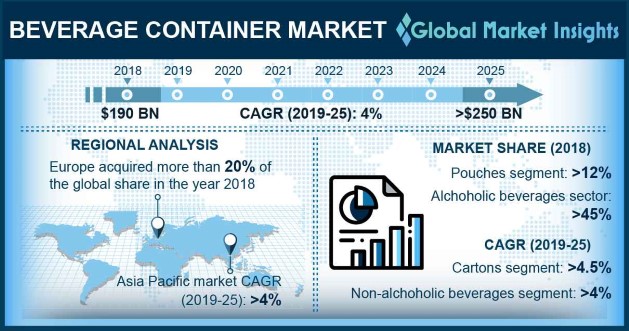Home > Packaging > Industrial Packaging > Industrial Wrapping and Protection > Global Beverage Container Market
Global Beverage Container Market Size
- Report ID: GMI140
- Published Date: May 2019
- Report Format: PDF
Global Beverage Container Market Size
Global Beverage Container Market size was valued at over USD 190 billion in 2018 and is anticipated to witness over 4% CAGR up to 2025.
Rinsing consumer preference for single serving containers coupled with constantly changing food industry landscape is expected to drive beverage container market growth. Demand growth can be attributed to container features such as protection from the external environment, product support, and resistance to product tampering. Propagation of see-through cans and bottles for enhancing the aesthetic appeal of beverages such as fruit juices, sports & energy drinks, and enhanced water will support business growth. Additionally, new product launches accompanied by aggressive marketing campaigns are anticipated to accentuate the industry growth over the forecast period.
Changing consumer preferences have led to the use of novel container materials to retain the aroma, enhance strength, provide thermal stability, protection against moisture and ensure recyclability. Increasing demand for small flexible containers provides new avenues for business expansion. Incorporation of novel packaging techniques will also help the market to gain noteworthy momentum. For instance, aseptic beverage packaging has witnessed high demand in the beverages industry as it improves the shelf life of the product by preserving its nutritional & organoleptic properties.
| Report Attribute | Details |
|---|---|
| Base Year: | 2019 |
| Beverage Container Market Size in 2019: | 190 Billion (USD) |
| Forecast Period: | 2019 to 2025 |
| Forecast Period 2019 to 2025 CAGR: | 4% |
| 2025 Value Projection: | 1.4 Billion (USD) |
| Historical Data for: | 2014 to 2018 |
| No. of Pages: | 350 |
| Tables, Charts & Figures: | 732 |
| Segments covered: | Material, Container Type, Application and Region |
Beverage manufacturers are expected to incorporate aesthetic beverage packaging as it is visually appealing and attracts consumer attention towards their products. Recyclable container materials such as aluminum and PET for packaging beverages have been a popular choice of manufacturers over the last few years. Also, plant-based material has become a popular choice among beverage manufacturers as it helps them to reduce their carbon footprint. For instance, In June 2018, So Delicious announced the launch of their organic almond milk in a 48-oz bottle made from bio-based plastic which offers the same benefits as traditional packaging while also ensuring its recyclability.
Growing concerns regarding the use of plastics and risk related to metal particles contaminating the products have led manufacturers to adopt paperboard for packaging of various beverages. For instance, WestRock Company announced the launch of paperboard can for the packaging of their energy drinks product line. Favorable policies and standards pertaining to the usage of packaging materials are expected to remold the overall industry landscape. For instance, FDA regulates packaging materials under section 409 of the federal food, drug and cosmetic act with an aim to nullify the negative effect of material on edible products.
The stringent environmental regulations are expected to create a hindrance to industry growth. For instance, the “European Parliament and Council Directive 94/62/EC on packaging waste” ensure that adequate steps are taken by manufacturers to counter industrial waste and increase recyclability. Other challenges faced by manufacturers are the declining soft drinks and alcohol sales over the last few years and the sluggish growth in other soft drinks’ markets in the last 5 years, which have hampered the growth of this market.

